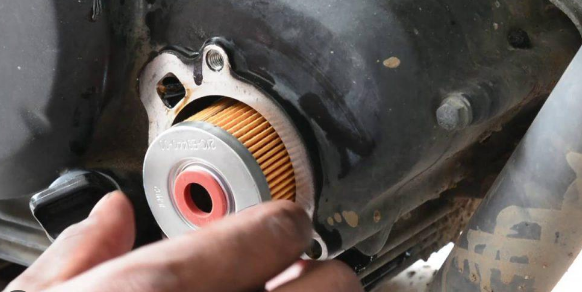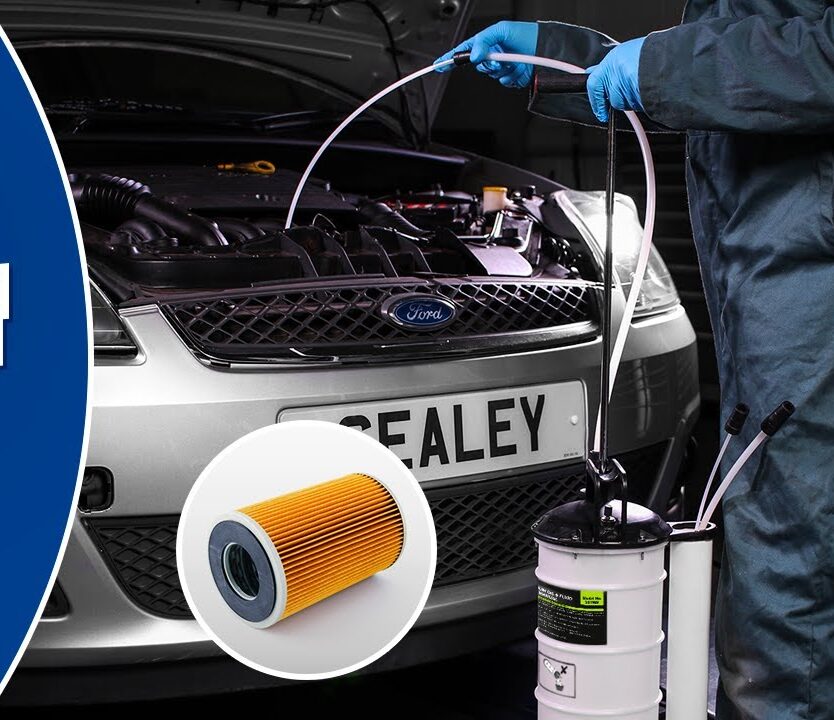No, you cannot change the oil filter without changing the oil. When changing the oil filter, it is essential to also change the oil as they are interconnected components of the engine’s lubrication system.
keeping the engine cleansible for removing contaminants from the oil, keeping the engine clean and running smoothly. Over time, the oil filter can become clogged and lose its effectiveness, leading to poor engine performance and potential damage. Therefore, it is necessary to change both the oil filter and the oil together to ensure optimal engine health and longevity.

Credit: www.amazon.com
Importance Of Regular Oil Filter Changes
Regular oil filter changes are crucial for the optimal performance and longevity of your engine. The primary function of an oil filter is to protect the engine from contaminants that can cause damage and wear to its components. By trapping and removing particles such as dust, dirt, and metal fragments, the oil filter ensures that the oil circulating through the engine remains clean and free from harmful substances.
Furthermore, a clean oil filter improves engine performance by allowing for proper lubrication. Adequate oil flow is necessary to minimize friction between moving parts and prevent overheating. Without a clean oil filter, the oil can become clogged and lose its effectiveness in providing lubrication, leading to increased friction and potential engine damage.
Regularly changing the oil filter also ensures that the engine receives the necessary amount of clean oil, which is essential for proper lubrication and cooling. Over time, oil can become contaminated and lose its ability to lubricate, compromising engine efficiency and potentially causing severe damage. Therefore, it is vital to change the oil filter regularly to maintain peak engine performance and extend its lifespan.
Consequences Of Not Changing Oil Filter
Consequences of not changing oil filter
When you neglect to change your oil filter regularly, it can lead to various consequences that can harm your engine’s performance and longevity.
Accumulation of dirt and debris:
Over time, the oil filter becomes clogged with dirt, debris, and contaminants from the engine. This buildup restricts the oil flow and prevents it from effectively lubricating the engine components.
Reduced oil flow:
A clogged oil filter hinders the smooth flow of oil throughout the engine. This restricted oil flow fails to adequately lubricate and cool the engine, resulting in increased friction and heat. As a result, the engine may overheat, leading to potential damage and wear.
Engine damage and increased wear:
Without proper filtration, dirty oil circulates through the engine, causing premature wear and tear on crucial engine parts. Over time, this can lead to significant engine damage, including increased friction, reduced power, and potential engine failure.
Understanding The Purpose Of An Oil Filter
An oil filter plays a crucial role in maintaining the overall health and performance of a vehicle’s engine. By filtering out impurities from the oil, it prevents contaminants from circulating within the engine’s components.
The oil filter ensures that the engine receives clean oil, allowing it to function optimally and reducing the risk of damage caused by debris or particles. Regularly changing the oil filter is essential, as a clogged or inefficient filter can lead to reduced oil flow and compromised lubrication.
While it is possible to change the oil filter without changing the oil, it is generally recommended to replace both simultaneously for maximum benefits. This helps to maintain the oil’s quality and ensure that the engine continues to run smoothly.
Limitations Of Changing Only The Oil Filter
Changing the oil filter without changing the oil has limitations that should be considered. Inadequate removal of sludge and old oil is one such limitation. Without changing the oil, sludge and contaminants can still accumulate in the engine, which can affect engine performance and longevity.
Additionally, simply replacing the oil filter without changing the oil can decrease the effectiveness of the new oil filter. Over time, the filter might become overloaded with debris, reducing its ability to effectively filter the oil and protect the engine.
This can lead to increased risk of engine damage and costly repairs in the long run. Therefore, it is important to change both the oil filter and the oil regularly for optimal engine health and performance.
Gather The Necessary Tools And Materials
Gather the necessary tools and materials:
- Oil filter wrench – You will need an oil filter wrench to remove the old oil filter. This tool grips the filter tightly and allows you to twist it off easily.
- Drain pan – Make sure to have a drain pan ready to catch the old oil when you remove the filter. This will help prevent any mess and make the process cleaner.
- New oil filter – Before you start, ensure you have a new oil filter on hand. It’s important to replace the old filter with a fresh one to ensure proper filtration and engine performance.
- Clean rag or paper towels – Keep a clean rag or paper towels nearby to wipe any excess oil or dirt off the engine and surrounding areas during the process.
- Gloves – It’s always a good idea to wear gloves when working with oil to protect your hands from any potential chemical exposure.
- Funnel adding new oil a funnel available to ensure a smooth and spill-free oil pouring process when adding new oil.
With these tools and materials at hand, you’ll be able to change your oil filter without changing the oil and maintain the optimal performance of your vehicle.
Prepare The Vehicle For The Oil Filter Change
Changing the oil filter without changing the oil is possible in certain situations. However, it is generally recommended to change both the oil and the oil filter at the same time for optimal engine performance and longevity.
Before proceeding with the oil filter change, it is important to prepare the vehicle properly. Park the vehicle on a level surface to ensure stability and safety during the process. Allow the engine to cool down for at least 15 minutes to reduce the risk of burns.
To access the oil filter, lift the vehicle using jack stands or ramps to create enough clearance. Make sure to follow the manufacturer’s instructions for proper placement of the jack stands to avoid any accidents.
Once the vehicle is properly prepared, the oil filter can be changed. However, it is highly recommended to also change the oil to ensure the best possible lubrication and protection for the engine.
Consult the vehicle’s owner manual or a professional mechanic for specific recommendations on oil filter and oil change intervals.
Locate And Remove The Old Oil Filter
Changing the oil filter without changing the oil is not recommended. However, if you still want to proceed, here are the steps to locate and remove the old oil filter:
| 1. | Consult the vehicle’s manual for the filter’s location |
| 2. | Use the oil filter wrench to loosen and remove the old filter |
| 3. | Dispose of the old filter properly |
Keep in mind that by not changing the oil, you are leaving dirty oil in the engine, which can lead to decreased performance and potential engine damage. It is essential to change both the oil and filter regularly to maintain the health of your vehicle.
Install The New Oil Filter
Install the new oil filter: To install the new oil filter, start by applying a thin film of clean oil to the gasket of the new filter. This will help ensure a tight seal and prevent oil leaks. Once the gasket is lubricated, screw the new filter into place by hand until it is snug.
Use the oil filter wrench: After the new filter is hand-tightened, use an oil filter wrench to give it an additional half-turn. This will provide the necessary tightness to ensure that the filter does not come loose during operation.
Changing the oil filter without changing the oil is a common misconception. While it is possible to change the oil filter without draining the oil, it is generally recommended to change both the filter and the oil at the same time. This ensures that your engine has clean oil and a fresh filter, promoting proper lubrication and extending the life of your engine.
Refill The Engine With Fresh Oil
If you’re wondering whether you can change the oil filter without changing the oil, the short answer is no. essential to refill the engine with fresh oilalth, it is essential to refill the engine with fresh oil after replacing the oil filter. This ensures that the engine has clean and properly lubricated components.
When it’s time to refill the engine, start by locating the oil filler cap. This cap is usually labeled ‘Oil’ and can be found on the top of the engine.
Once you’ve found it, insert a funnel into the opening and carefully pour the recommended amount of oil into the engine. Be sure to use the type and viscosity of oil specified in your vehicle’s owner’s manual.
After pouring the oil, make sure to replace the oil filler cap securely. This will prevent any leaks or contamination and help maintain the proper oil pressure in the engine.
Remember, changing the oil filter without changing the oil is not recommended. It’s crucial to follow the complete oil change procedure for optimal engine performance and longevity.
Start The Engine And Check For Leaks
To change an oil filter without changing the oil, you should start the engine and check for leaks. Allow the engine to run for a few minutes.
Inspect for any oil leaks around the filter and drain plug. If you notice any leaks, address them immediately. It is important to keep an eye out for leaks to prevent further damage to the engine.
Regular Oil Filter Changes Are Crucial For Engine Health
Proper maintenance ensures optimal engine performance. Neglecting oil filter changes can lead to a plethora of issues and significantly shorten the lifespan of your engine.
The oil filter plays a vital role in removing contaminants, such as dirt, debris, and metal fragments, from the motor oil, preventing them from circulating through the engine. Over time, these contaminants can cause damage to crucial engine components, leading to reduced performance and potential breakdowns.
Changing the oil filter without changing the oil may seem like a cost-effective or time-saving solution, but it is not recommended. While the filter may be able to capture some of the contaminants initially, the old oil still contains harmful particles and contaminants.
By only changing the filter, you’re not addressing the buildup of sludge and other impurities that can affect engine performance and longevity.
In conclusion, it is essential to change both the oil and oil filter at regular intervals as recommended by the vehicle manufacturer. This ensures that your engine remains clean and well-lubricated, promoting optimal performance and extending its lifespan.
Conclusion
Changing the oil filter without changing the oil is not recommended for optimal engine performance and longevity. While it may seem like a cost-saving measure, neglecting to change the oil along with the filter can result in contaminated oil that is unable to properly lubricate the engine, leading to potential damage.
Regular oil and filter changes are essential maintenance tasks to keep your engine running smoothly and efficiently. Trust the experts and follow the recommended maintenance schedule for the best results.


Leave a Reply